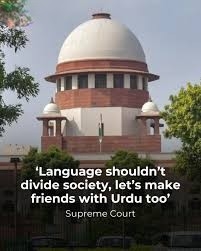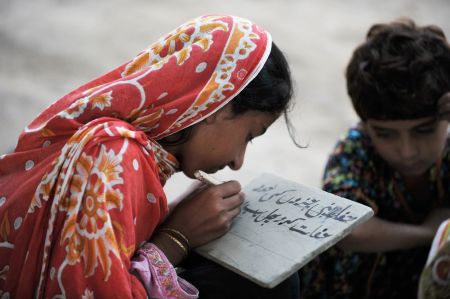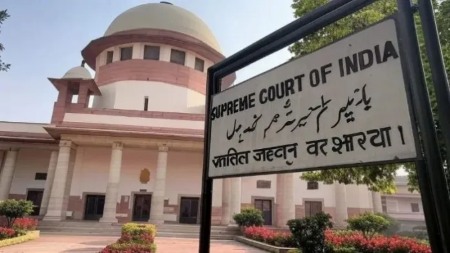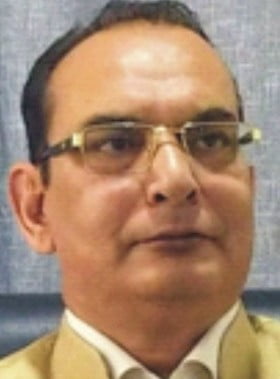The Battle for Urdu’s Identity, its Cultural Heritage, and the Constant Struggle for Recognition — Now Rekindled by a Landmark Supreme Court Observation
LAST WEEK, a Supreme Court bench’s observation on the use of Urdu once again opened a Pandora’s box on the treatment meted out to Urdu – a language of connoisseurs, which has, however, been associated with the Muslim community. As in the past, this time too, nothing worthwhile will come out of this development, as Urdu has been relegated to its current status by its own lovers.
 A Supreme Court bench comprising Justice Sudhanshu Dhulia and Justice K. Vinod Chandran, while hearing a petition by Varshatai Sanjay Bagade, a former councillor of Patur in Maharashtra’s Akola district, rejected a challenge to the use of Urdu on the signboard of a municipality in Maharashtra.
A Supreme Court bench comprising Justice Sudhanshu Dhulia and Justice K. Vinod Chandran, while hearing a petition by Varshatai Sanjay Bagade, a former councillor of Patur in Maharashtra’s Akola district, rejected a challenge to the use of Urdu on the signboard of a municipality in Maharashtra.
Ms. Bagade had challenged the use of Urdu, along with Marathi, on the nameboard of the municipal council. She argued that the work of the Municipal Council could only be conducted in Marathi, and that the use of Urdu was impermissible, even on the signboard.
In its observations, the two judges referred to many oft-repeated sentiments regarding the Urdu language. The Honourable judges, quoting an extract from a Nazm by poet Iqbal Ashhar, noted that if Urdu were to speak for herself, she would say:
“Urdu hai mirā naam, maiñ ‘Khusrav’ kī pahelī
kyuuñ mujh ko banāte ho ta.assub kā nishāna
maiñ ne to kabhī ḳhud ko musalmāñ nahīñ maanā
dekhā thā kabhī maiñ ne bhī ḳhushiyoñ kā zamāna
apne hī vatan meñ huuñ magar aaj akelī,
urdu hai mirā naam maiñ ‘Khusrav’ kī pahelī”
(Urdu is my name, I am the riddle of ‘Khusro’
Do not hold me for your prejudices
I never considered myself a Muslim
I too have seen happier times
I feel like an outsider in my homeland today
Urdu is my name, I am the riddle of ‘Khusro’)
The learned judges further rightly commented that no language can be described as belonging to a religion. To consider Urdu a language of Muslims is a “pitiable digression” from reality and a departure from India’s unity in diversity.
 “Language belongs to a community, to a region, to people; and not to a religion. Language is culture. Language is the yardstick to measure the civilisational march of a community and its people. So is the case with Urdu, which is the finest specimen of Ganga-Jamuni tahzeeb, or Hindustani tahzeeb, the composite cultural ethos of the plains of northern and central India. But before language became a tool for learning, its earliest and primary purpose will always remain communication,” the court said.
“Language belongs to a community, to a region, to people; and not to a religion. Language is culture. Language is the yardstick to measure the civilisational march of a community and its people. So is the case with Urdu, which is the finest specimen of Ganga-Jamuni tahzeeb, or Hindustani tahzeeb, the composite cultural ethos of the plains of northern and central India. But before language became a tool for learning, its earliest and primary purpose will always remain communication,” the court said.
The court observed that the Patur Municipal Council had retained Urdu on the nameboard because many local residents understood the language. The Municipal Council’s intent was simply to ensure effective communication, the court stated.
The court said that a Municipal Council provides services to the local community and caters to their immediate day-to-day needs. “If people or a group of people residing within the area covered by the Municipal Council are familiar with Urdu, then there should not be any objection to its use in addition to the official language, i.e., Marathi, at least on the signboard of the Municipal Council. Language is a medium for the exchange of ideas that brings people holding diverse views and beliefs closer, and it should not become a cause of their division.”

Apparently, the bench aptly surmised that, “The prejudice against Urdu stems from the misconception that Urdu is alien to India. This opinion, we are afraid, is incorrect as Urdu, like Marathi and Hindi, is an Indo-Aryan language. It is a language that was born in this land. Urdu developed and flourished in India due to the need for people belonging to different cultural milieus who wanted to exchange ideas and communicate amongst themselves. Over the centuries, it attained ever greater refinement and became the language of choice for many acclaimed poets.”
The court noted that the fusion of Hindi and Urdu faced a roadblock in the form of purists on both sides, with Hindi becoming more Sanskritized and Urdu becoming more Persianized. “A schism was exploited by colonial powers in dividing the two languages on religious lines. Hindi was now understood to be the language of Hindus and Urdu of Muslims, which is a pitiable digression from reality, from unity in diversity, and the concept of universal brotherhood.”
 The Court pointed out that the Constitution mentions 22 Indian languages in its 8th Schedule, which includes both Marathi and Urdu. Significantly, ‘English’ is not listed in the Schedule as it is not an Indian language.
The Court pointed out that the Constitution mentions 22 Indian languages in its 8th Schedule, which includes both Marathi and Urdu. Significantly, ‘English’ is not listed in the Schedule as it is not an Indian language.
The court further observed that the Hindustani language used by the masses is replete with Urdu, even if one is not aware of it. “It would not be incorrect to say that one cannot have a day-to-day conversation in Hindi without using words of Urdu or words derived from Urdu. The word ‘Hindi’ itself comes from the Persian word ‘Hindavi’,” it said.
This exchange of vocabulary flows both ways because Urdu also has many words borrowed from other Indian languages, including Sanskrit. Furthermore, Urdu words have a heavy influence on the judiciary, both in criminal and civil laws, and in police vocabulary, although recently, many overzealous state governments have issued directives to state police forces to adopt Hindi or words from the official state language in official correspondence and FIR filing.
Words like Mukaddama (case), Mulzim (accused), Ilzam (allegation), Ittila (information), Chashmdeed (eyewitness), Mustaghees (complainant), Jeb Tarashi (pickpocketing), Ferd Baramadgi (recovery memo), Adalat (court), Halafnama (deposition), and Peshi (hearing date) abound in court and police correspondence.
 The Three Language Formula of 1968, which promotes state languages along with English and Hindi as compulsory languages at the school level, acts as the main villain against the use and spread of Urdu in India.
The Three Language Formula of 1968, which promotes state languages along with English and Hindi as compulsory languages at the school level, acts as the main villain against the use and spread of Urdu in India.
Urdu lovers have responded similarly to these issues whenever rabble-rousers raise banners against Urdu while promoting Hindi. But these forces are not ready to listen to any sane argument in favour of Urdu. Thus, the observation by the two learned judges will also be forgotten very soon, while anti-India and anti-Urdu elements will continue their tirade in the absence of any collective response from the Urdu lovers of the country.
In its concluding remarks, the Court urged that our misconceptions, perhaps even our prejudices against a language, must be courageously and truthfully tested against the reality, which is the great diversity of India. “Our strength can never be our weakness. Let us make friends with Urdu and every language.” ![]()
________
Also Read:
Urdu poetry is thoroughly secular
Disclaimer : PunjabTodayNews.com and other platforms of the Punjab Today group strive to include views and opinions from across the entire spectrum, but by no means do we agree with everything we publish. Our efforts and editorial choices consistently underscore our authors’ right to the freedom of speech. However, it should be clear to all readers that individual authors are responsible for the information, ideas or opinions in their articles, and very often, these do not reflect the views of PunjabTodayNews.com or other platforms of the group. Punjab Today does not assume any responsibility or liability for the views of authors whose work appears here.
Punjab Today believes in serious, engaging, narrative journalism at a time when mainstream media houses seem to have given up on long-form writing and news television has blurred or altogether erased the lines between news and slapstick entertainment. We at Punjab Today believe that readers such as yourself appreciate cerebral journalism, and would like you to hold us against the best international industry standards. Brickbats are welcome even more than bouquets, though an occasional pat on the back is always encouraging. Good journalism can be a lifeline in these uncertain times worldwide. You can support us in myriad ways. To begin with, by spreading word about us and forwarding this reportage. Stay engaged.
— Team PT

